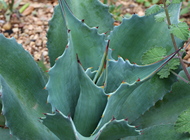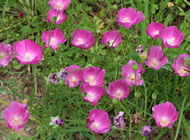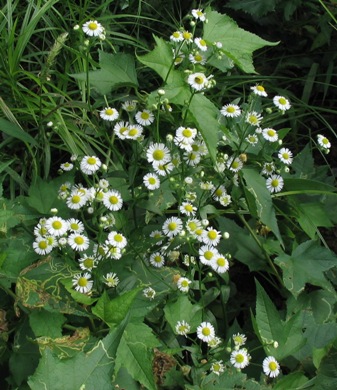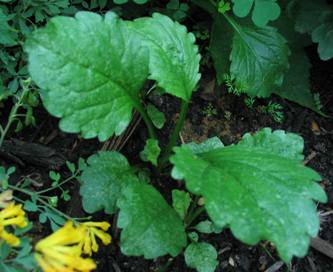 |
Erigeron annuus |
 |
|
|
| Common name |
Eastern daisy fleabane |
| Family |
asteraceae |
| Life cycle |
annual |
| Flowers |
white/yellow (summer) |
| Size |
3-5' |
| Light |
sun-part shade |
| Cultural notes |
ordinary garden soil |
From seed  |
self-seeds in our garden
|
Young plants look very different from the mature, flowering plant, and have often fooled me into believing it was something desirable. Now I know better - even though the small white daisies are cute, the fluffy seedheads are messy, and give rise to an abundance of seedlings.
|
This is a weed in our garden About my plant portraits
PlantLinks to other web pages about Erigeron annuus
Visitors to this page have left the following comments| Dave Berkshire | Jul 16, 2005 | Full plant portrait is beautifully composed.
Ma Nature did it for me :-) |
| ThamWaI Keong | Jul 29, 2006 | Hi,
I'm Tham from Malaysia.
The eastern daisy fleabane is actually a powerful herb for
the heart. While searching Medline for herbs which might
inhibit the latest heart marker enzyme, Lp-PLA2 (lipoprotein
-phospholipase A2), I came across this Korean study.
Searching further for this herb, I came across your website.
Ergosterol peroxide from flowers of Erigeron annuus L. as an
anti-atherosclerosis agent.
* Kim DH,
* Jung SJ,
* Chung IS,
* Lee YH,
* Kim DK,
* Kim SH,
* Kwon BM,
* Jeong TS,
* Park MH,
* Seoung NS,
* Baek NI.
Graduate School of Biotechnology & Plant Metabolism Research
Center, Kyung Hee University, Suwon 449-701, Korea.
Flowers of Erigeron annuus L. were extracted with 80% aqueous
MeOH, and the concentrated extract was partitioned with EtOAc,
n-BuOH, and H2O. Repeated silica gel and ODS column
chromatography of the EtOAc fraction led to the isolation of a
sterol, through activity-guided fractionation, using ACAT inhibitory
activity measurements. From the physico-chemical data, including
NMR, MS, and IR, the chemical structure of the compound was
determined to be an ergosterol peroxide (1), which has been
isolated for the first time from this plant. This compound exhibited
hACAT-1 and Lp-PLA2 inhibitory effects, with inhibitory values of
51.6 +/- 0.9 and 51.7 +/- 1.2%, at a treatment concentration of 0.23 mM.
|
I welcome comments about my web pages; feel free to use the form below to
leave feedback about this particular page. For the benefit of other visitors
to these pages, I will list any relevant comments you leave, and if
appropriate, I will update my page to correct mis-information. Faced with an
ever-increasing onslaught of spam, I'm forced to discard any comments including
html markups. Please submit your comment as plain text. If you have a
comment about the website as a whole, please leave it in my
guestbook. If you
have a question that needs a personal response, please
e-mail me.
Last modified:
September 13, 2004
Contact me
|




